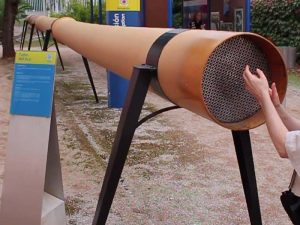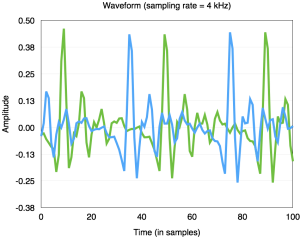The slides from my (Simon’s) keynote are now online under Courses > One-off events. I’ll try to add a recording and perhaps a bibliography later.
Bitrate
The bitrate (or bit rate) of a signal is the number of bits required to store, or transmit, 1 s of that signal. A bit is a binary number: either 0 or 1. Let’s calculate the bitrate of a digital waveform. First you should revise the concepts of sampling and quantisation from this module of the […]
Interactive unit selection
Just a toy demo, but should give you some idea of how unit selection waveform generation works. Click with your mouse to choose a candidate diphone from each column, then the corresponding synthesised waveform will appear. You can click on the synthesised waveform to hear it again. Try to obtain the most natural-sounding synthesis by […]
The speed of sound
At the Parque de las Ciencias in Granada, Spain there is this long tube, open at the end nearest you and closed at the far end. We can calculate the length of this tube just from the audio recording, because we know the speed of sound. Here’s the waveform of part of the recording, showing […]
Wave propagation on the surface of water
At the Alhambra (Granada, Spain) I saw this nice example of waves from a point source propagating in all directions at a fixed speed.
Autocorrelation for estimating F0
Most methods for estimating F0 start from autocorrelation. The idea is pretty simple: we are just looking for a repeating pattern in the waveform, which corresponds to the periodic vocal fold activity. For some waveforms, it might be possible to do that directly in the time domain, but in general that doesn’t work very well. […]
The Gaussian probability density function: understanding the equation
The equation for the Gaussian probability density function looks a little scary at first, but this video should help you understand what each of the terms is doing, and how they fit together. After watching the video download the spreadsheet which shows the calculations and plots from this video (tip: the Apple Numbers.app version includes images […]
Token passing
Token passing is a really nice way to understand (and even to implement) Viterbi search for Hidden Markov Models. Here we see token passing in action, and you can look at the spreadsheet to see the calculations. To keep things simple, we are ignoring transition probabilities in this example. It would be simple to add them […]
A super-simple speech recogniser
We make what is possibly the world’s simplest speech recognition system. It can only recognise two different words, but will help you understand the basic idea of pattern recognition using template matching. The templates are just pre-recorded words, with known labels. The features extracted are just two formant frequencies in the middle of the word, […]
TD-PSOLA …the hard way
Time-Domain Pitch Synchronous Overlap and Add (TD-PSOLA) can modify the fundamental frequency and duration of speech signals, without affecting the segment identity – that is, without changing the formants. Normally, it’s an automatic algorithm, but here we do it the hard way – by hand! If you want to follow-along, you will need Audacity and these materials (a […]
Entropy: understanding the equation
The equation for entropy is very often presented in textbooks without much explanation, other than to say it has the desired properties. Here, I attempt an informal derivation of the equation starting from uniform probability distributions. A good way to think about information is in terms of sending messages. In the video, we send messages […]
A simple synthetic vowel
Using Praat, we synthesise a simple vowel-like sound, starting with a pulse train, which we pass through a filter with resonant peaks.












 This is the new version. Still under construction.
This is the new version. Still under construction.